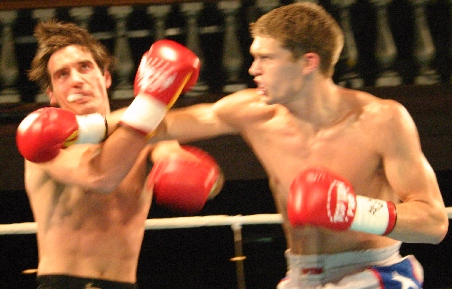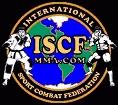FOR SAME ARTICLE WITH NO PHOTOS - CLICK HERE
"Fighters Don't Die
In The Ring"
Second-Impact
Syndrome
Trainers...
IS YOUR FIGHTER SAFE?
Are Your Fighter's Fighting Too Quickly After A
KO/TKO
In The Gym? Or Even WITHIN A
Mandated Medical Suspension?

This article is not intended as a
medical article for doctors.
However it's goal is to inform trainers and all
others who are involved with the safety of fighters of the severity of this
potential injury. This article was written from research compiled by
Steve
Fossum, President and CEO of International Fight Sports and Commissioneer of the
IKF -
International Kickboxing Federation, the
ISCF - International
Sport Combat Federation the IAB, - International Association of Boxing along
with numerous sources and the assistance of Hall of Fame Ringside Medical
Doctor,
Dr.
Allan Fields who is Chief Medical Advisor for many fight sport
sanctioning bodies (Boxing, Kickboxing, Muay Thai & Mixed Martial Arts)
Chief Medical Advisor and Ringside Physician for the State of Florida and on the
Executive Committee, the Board of Directors and the Medical Review Board of the
American Association of Professional Ringside Physicians,
which is an international, non-profit organization dedicated to the health and
safety of the professional and amateur boxer.
Your fighter is strong, fast and talented and tonight he/she is in one of the toughest bouts of their lives. The crowd is cheering and the action in the ring is nothing short of "Explosive" by both competitors! When the final bell sounds and the judges scores are read, your fighter wins one of the greatest bouts of his or her life! All is Good!
Sadly what you and your fighter don't know is just how much damage was done in tonights bout. Things may all seem normal after tonights win, but lurking in the darkness is an unforeseen injury that will change the lives of many...
Three weeks later, your fighter is in a much easier bout, and takes a punch to the head that looks like any other head blow, however, the damage that some will believe just happened, actually happened three weeks ago. Your fighter falls to the canvas and lapses in and out of consciousness until finally, they are out cold. Emergency medical staff is immediately by your fighters side and they quickly rush him to a trauma center. Doctors quickly diagnose the problem as... Second-impact syndrome and your fighter is rushed to surgery... Sadly, within hours after the surgery, your fighter is gone, and the questions begin... How and Why?
What is Second-Impact
Syndrome?
Second-impact syndrome (SIS) is a condition in
which the brain swells rapidly and catastrophically after a person suffers a
second concussion before symptoms from an earlier one have subsided. This deadly
second blow may occur days, weeks or minutes after an initial concussion, and
even the mildest grade of concussion can lead to SIS. SIS is the most serious
potential complication that could result from an athlete returning to train or
fight before symptoms from a minor head injury have subsided. Such symptoms
include headache, cognitive difficulties, or visual changes.
The initial injury may be a concussion, or it may be another, more severe, type of head trauma, such as cerebral contusion. However, the first concussion need not be severe for the second impact to cause SIS. Also, the second impact may be very minor, even a blow such as an impact to the chest that causes the head to jerk, thereby transmitting forces of acceleration to the brain.
Loss of consciousness during the second injury is not necessary for SIS to occur. Both injuries may take place the same day, maybe even in the same fight. The fighter may continue fighting after the second concussion, and may walk out of the ring without assistance, but symptoms quickly progress and the condition can rapidly worsen.
They usually remain alert on their feet for 15 seconds to 1 minute or so but seem dazed. Usually within seconds to minutes of the second impact, the fighter, conscious but stunned, suddenly collapses, semi-conscious with rapidly dilating (widening) pupils and loss of eye movement, and stops breathing.
|
Pathophysiology is the study of the
changes of normal mechanical, physical, and biochemical functions, either caused
by a disease, or resulting from an abnormal syndrome. More formally, it is the
branch of medicine which deals with any disturbances of body functions, caused
by disease or prodromal symptoms.
|
OUTCOME AFTER INJURY
Neurological
collapse can occur within a short period, with rapid onset of dilating pupils,
loss of eye movement, unconsciousness, and respiratory failure. The most
shocking of all is how quickly failure of the brain stem can occur. Between two
and five minutes of the second impact, death can follow shortly making you
realize, that the time it took from impact to the operating table was
meaningless. SIS is often documented as a "Non survivable injury".
TREATMENT
Treatment of the loss of autoregulation of the brain's blood
vessels may be difficult or impossible. When SIS occurs, surgery does not help
and there is little hope for recovery. Treatment requires immediate recognition
and includes administration of osmotic agents and hyperventilation in order to
lower intracranial pressure.
Although the condition is often fatal, almost everyone who is not killed is severely disabled. The cause of SIS is uncertain, but it is thought that the brain's arterioles lose their ability to regulate their diameter, and therefore lose control over cerebral blood flow, causing massive cerebral edema. Athletes are most at risk and in order to prevent SIS, guidelines have been established to prohibit athletes from returning to the fight game prematurely. This is why regulatory bodies for the fight game give fighters medical suspensions of a minimum of 30 days. However, in the case above, injuries don't always happen to the losing fighter who just suffered a TKO or Knockout.
After a TKO or KO, ringside doctors are required to suspend a fighter for a determined period of time by recommending the fighter not return to fight (Or even train in a gym) before symptoms of an initial head injury have resolved. Due to the very small number of recorded cases of SIS, there is doubt about whether it is a valid diagnosis. However, the syndrome is recognized by physicians.
PREVENTION
Measures
that prevent head injuries in general also prevent SIS. This of course is the
reason amateur fighters are often advised or required to use headgear. However
the use of headgear does not entirely prevent the syndrome. Experts advise that
fighters who have suffered one concussion and still complain of
concussion-related symptoms be prohibited from returning to the ring due to the
possibility of developing SIS. Fighters are also discouraged from returning to
even work-out in the gym until after they have been evaluated and approved for
resuming by a health care provider skilled in evaluating concussion. Some
fighters may verbally deny concussion symptoms because they do not wish to be
prevented from training or missing a highly anticipated bout. This is where
education by a skilled trainer is vital... The fighter needs to be informed by
their trainer what to look out for to in a sense, "Help them help
themselves."
TRAINER ERROR?
In
most cases of SIS, the individual had received another concussion previously. If
you are a trainer, ask yourself how many times have your fighters been "Clocked"
in the gym? How many times have you had a fighter knocked down, or even knocked
out in the gym? Sadly, we all know, such incidents are not reported, and very
few fighters as well as trainers feel they need to take a 30-45 day break after
such an occurrence. This could very well be where the extent of the damage was
caused that ultimately lead to the fighters death, days or even weeks later.
Trainers "Should" prohibit a fighter from training in the gym as well as fighting again who has suffered a concussion, regardless of the speed with which the symptoms reportedly resolve. An initial head injury may impair an athlete's judgment and ability to decide to refrain from participating in risky activity, so some health care providers encourage family members (MORE SO, THEIR TRAINERS) and other acquaintances to pressure a fighter not to return to train or fight until they have been cleared by a physician.
If fighter is suspected of having a concussion, a very basic neurological evaluation should be performed. If a medical professional is not immediately available, the examination can be performed by a trainer or another fighter. Assess the injured fighter's level of consciousness, concentration, speech, memory, vision, and coordination. Below is a simple outline of an exam:
|
Simple Neurological Exam | |
|
Orientation |
Have fighter name city, opponent, day, month, and year. |
|
Concentration (Immediate) |
Have fighter repeat five words in correct order. |
|
Retrograde Amnesia |
Have fighter recall events prior to the injury to check for retrograde amnesia. |
|
Memory (recall) |
Have fighter repeat the same five words in correct order after a 5 minute delay. |
|
Vision |
Have fighter count your fingers and look into fighter's eyes to see if the pupils are the same size. |
|
Coordination |
Have fighter stand on one foot to assess balance. |
If the fighter has lost consciousness, they should be
transported to a hospital immediately. If the fighter is unable to perform the
simple exam outlined above, they should be transported to the hospital. If a
fighter has any symptoms related to a concussion, the fighter should not
continue with the current training session or match. The fighter should be
evaluated by a physician before returning to competition. Most importantly, a
fighter who experiences symptoms following a concussion requires serial
neurologic evaluations for as long as the symptoms persist to determine if the
fighter's condition is deteriorating. Observation of the fighter may be
permitted at home if the physician determines the neurologic condition is very
unlikely to deteriorate. Another person (an observer) should be in close
contact to the fighter for the first 24 hours. The observer needs to be given
explicit instructions on monitoring the following:
- Inability to awaken the fighter.
- Severe or worsening headaches.
- Somnolence or confusion.
- Seizures.
- Visual disturbances.
- Vomiting.
- Urinary or bowel incontinence.
- Weakness or numbness of any body region.
The fighter should be awakened every two hours for the first night and stay away from all strenuous activity for 24 hours. If any of the above signs are present, this may indicate increased brain swelling or hemorrhage caused by brain contusions (bruises). This is an indication to seek immediate additional medical care at a local hospital. Furthermore, a fighter will be held from competition and activity for a minimum of one week. Return to competition will be determined by the physician based on the fighter's traumatic brain injury (TBI) history and absence of symptoms.
Several different sets of "Return-to-play" guidelines exist for athletes who have suffered minor head trauma. These exist in part to prevent the player from developing SIS. A variety of concussion grading systems have been devised, in part to aid in this determination. Every return-to-play guideline recommends that an athlete not return to competition until all concussion symptoms are absent during both rest and exercise. The American Academy of Neurology recommends that young athletes be prohibited from returning to play for at least a week in most cases of concussion. The current return-to-play guidelines (Below) may not be strict enough to protect young athletes from SIS. This is why many State Athletic Commissions regulating fight sports established minimum medical suspension requirements for fighters who have been stopped in their bout due to blows or even knocked out in their bout. From these State Athletic Commission requirements, other regulatory and fight sanctioning bodies ( EX: IKF ) have adopted the very same suspensions.
The Colorado Medical Society guidelines were published in 1991 in response to the death of a high school athlete due to what was thought to be second-impact syndrome. According to the guidelines, a grade I concussion consists of confusion only, grade II includes confusion and post-traumatic amnesia, and grade III and IV involve a loss of consciousness. By these guidelines, an athlete who has suffered a concussion may return to sports after having been free of symptoms, both at rest and during exercise, as shown in the following table:
|
| ||
|
Grade |
First Concussion |
Subsequent Concussions |
|
I |
15 Minutes |
1 Week |
|
II |
1 Week |
2 Weeks, With Physician Approval |
|
IIIa |
1 Month |
6 Month, With Physician Approval |
|
IIIb |
6 Months |
1 Year, With Physician Approval |
In schools across America it is now being recommended by
the
Centers for Disease Control and state athletic organizations that
coaches be trained in managing athlete concussions according to current
guidelines. However, sadly there is no such requirement for trainers of fighters
in the fight world. In fact, there are very few requirements "IF ANY"
as requirements to be a trainer of a full contact fighter(s) (Kickboxing,
Muay Thai, MMA, Boxing). In fact, being a fight trainer is more often judged
upon how well the trainer can teach a fighter how to fight, and not how to
survive, such as knowing things like the graph above.
Regulatory bodies, sanctioning bodies and State Athletic Commissions require their ringside physicians to place fighters who have been TKO'ed and Knocked Out on medical suspensions beginning at 30 days ( EX: IKF ). Sometimes the ringside doctor may place a fighter on medical suspension simply due to the fact they were in a hard fought bout, a bout they could have even won. Most trainers and fighters believe their issued medical suspension is the number of days before they are allowed to fight again, however, this is only partly true. As noted above, a fighter who has received too many strong blows or has been knocked unconscious (Even if in the Gym in Sparring!) needs time to recover, which means they should not even be in the gym, hitting a bag, let along sparring, let alone "Fighting" within their suspension time.
Sadly, too often, whether it be the eager fighter seeking another opportunity or an inexperienced trainer with no concept of fighter safety, we hear about a fighter fighting inside their regulated medical suspension. Sure, they can do so and maybe nothing will happen... However, it only takes one time... A fighter is training hard for a much anticipated bout, sparring hard in the gym and while doing so is dropped by their sparring partner, maybe even losing consciousness... They are quickly revived by their trainer and training partners and of course told how tough they are after taking such a shot. "Shake it off, you will be fine!" And as noted above, they can do so and maybe nothing will happen.. But again, "It only takes once..." Days or weeks later in the middle of a bout, the fighter drops from a non knockout blow, drifts in and out of consciousness before blacking out... The damage is done, in fact, the damage was done days, maybe even weeks ago and instead of being safe, keeping his fighter from potential harm, the trainer now is wondering "What happened?"
- References
- Dr. Allan Fields
- Times-news.com
- Colorado Medical Society
- Centers for Disease Control
- American Academy of Neurology
- IAB - International Association of Boxing
- IKF - International Kickboxing Federation
- Nevada Boxing, Las Vegas, Nevada, USA
- University of South Florida, Tampa, FL, USA
- ISCF - International Sport Combat Federation
- Various Doctors related to concussion research
- South Shore Hospital, South Weymouth, MA, USA
- Steve Fossum, President/CEO International Fight Sports
- USA Today - Society for the Advancement of Education
- Neurosurgery Service, Emerson Hospital, Concord, Massachusetts, USA
For this
article on it's own page without any photos
"CLICK HERE"
|
ABOUT IFS --- SANCTIONING --- OFFICIALS CERTIFICATION--- COMPANIES --- ON THE ROAD --- CONTACT | ||||


